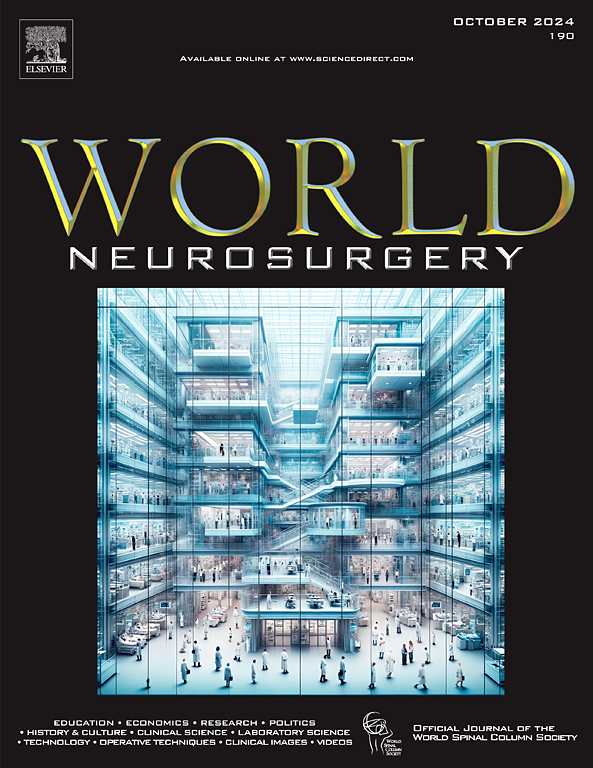腰椎前外侧椎间融合术后术前多股肌和腰大肌质量与患者报告结果:术前残疾和背痛改善的预测因素。
IF 1.9
4区 医学
Q3 CLINICAL NEUROLOGY
引用次数: 0
摘要
目的研究腰椎前外侧椎体间融合术(A-LLIF)术前腰多裂肌(LMM)和腰大肌(PMM)质量与术前和术后患者报告结果(PROs)之间的关系:我们对 2017-2022 年期间在一家机构接受 L1 和 S1 之间 A-LLIF 术的患者进行了回顾性审查,这些患者至少接受了约 1 年的随访,且有术前 MRI 可供使用。术前磁共振成像使用两个图像分析平台(AMBRA 和 ImageJ)进行分析。研究参数包括横截面积(CSA)和脂肪浸润(FI)指数。采用皮尔逊相关分析和多元线性回归分析来研究肌肉质量与术前、术后 PROs 之间的关系。对 LMM CSA 百分位数和既往手术分层进行了子分析:100 名患者符合纳入标准(平均 [SD] 年龄为 65.3 [11.0] 岁;57% 为女性,43% 为男性),平均(SD)随访时间为 1.29 (0.20) 年。共分析了 207 例手术水平。较小的 LMM CSA 与较高的术前残疾和术前背痛显著相关(p结论:研究发现,LMM CSA与术前残疾和背痛之间存在明显关联。与LMM较大(CSA大于12平方厘米)的A-LLIF患者相比,LMM CSA为2的患者术前残疾和背痛程度明显更高。本文章由计算机程序翻译,如有差异,请以英文原文为准。
Preoperative Multifidus and Psoas Major Muscle Quality and Patient-Reported Outcomes After Anterolateral Lumbar Interbody Fusion: Predictors for Preoperative Disability and Back Pain Improvement
Objective
To investigate associations between preoperative lumbar multifidus muscle (LMM) and psoas major muscle qualities and preoperative and postoperative patient-reported outcomes (PROs) after anterolateral lumbar interbody fusion (A-LLIF).
Methods
A retrospective review was conducted of patients with A-LLIF between L1 and S1 during 2017–2022 at a single institution who had at least approximately 1 year of follow-up and preoperative magnetic resonance imaging available. Preoperative magnetic resonance imaging was analyzed using 2 image analysis platforms (AMBRA and ImageJ). Parameters studied included cross-sectional area (CSA) and fat infiltration indices. Pearson correlation and multiple linear regression analyses were used to study relationships between muscle quality and preoperative and postoperative PROs. Subanalyses were performed for LMM CSA percentiles and stratification of previous surgery.
Results
One hundred patients met the inclusion criteria (mean [standard deviation] age, 65.3 [11.0] years; 57% women, 43% men) during a mean (standard deviation) follow-up period of 1.29 (0.20) years. In total, 207 surgical levels were analyzed. Smaller LMM CSA was significantly associated with greater preoperative disability and preoperative back pain (P < 0.04 [ImageJ]). There were no statistically significant confounding factors. Patients with greater LMM CSA and previous lumbar procedures (n = 42) had more improvement in visual analog scale for lower back pain delta scores (P = 0.02 [ImageJ]; P = 0.04 [AMBRA]). Neither LMM fat infiltration indices nor psoas major muscle morphology influenced PROs.
Conclusions
Significant associations were found between LMM CSA and preoperative disability and back pain. Compared to A-LLIF patients with larger LMM (CSA >12 cm2), those with LMM CSA <5 cm2 had significantly greater preoperative disability and back pain.
求助全文
通过发布文献求助,成功后即可免费获取论文全文。
去求助
来源期刊

World neurosurgery
CLINICAL NEUROLOGY-SURGERY
CiteScore
3.90
自引率
15.00%
发文量
1765
审稿时长
47 days
期刊介绍:
World Neurosurgery has an open access mirror journal World Neurosurgery: X, sharing the same aims and scope, editorial team, submission system and rigorous peer review.
The journal''s mission is to:
-To provide a first-class international forum and a 2-way conduit for dialogue that is relevant to neurosurgeons and providers who care for neurosurgery patients. The categories of the exchanged information include clinical and basic science, as well as global information that provide social, political, educational, economic, cultural or societal insights and knowledge that are of significance and relevance to worldwide neurosurgery patient care.
-To act as a primary intellectual catalyst for the stimulation of creativity, the creation of new knowledge, and the enhancement of quality neurosurgical care worldwide.
-To provide a forum for communication that enriches the lives of all neurosurgeons and their colleagues; and, in so doing, enriches the lives of their patients.
Topics to be addressed in World Neurosurgery include: EDUCATION, ECONOMICS, RESEARCH, POLITICS, HISTORY, CULTURE, CLINICAL SCIENCE, LABORATORY SCIENCE, TECHNOLOGY, OPERATIVE TECHNIQUES, CLINICAL IMAGES, VIDEOS
 求助内容:
求助内容: 应助结果提醒方式:
应助结果提醒方式:


